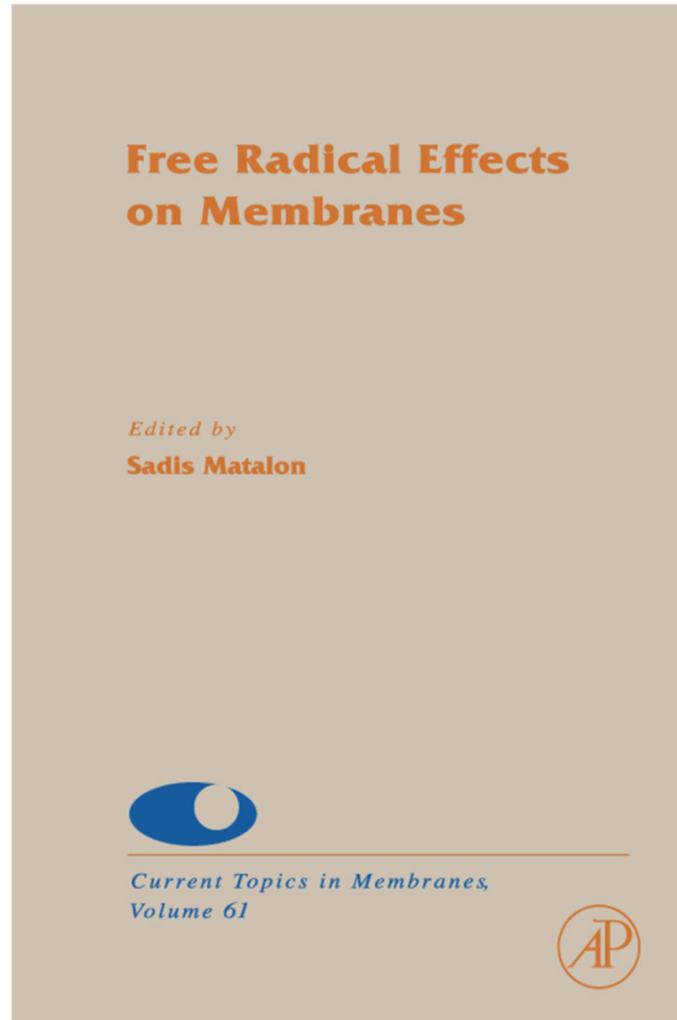Current Topics in Membranes provides a systematic, comprehensive, and rigorous approach to specific topics relevant to the study of cellular membranes. This volume consist of eleven chapters from experts in the field that encompass free-radical effects on diverse membrane functions, ranging from selective barrier functions, controlling membrane protein function to discussing how the hydrophobic environment within membranes regulate free radical reactivity. The focus is on articles discussing specific examples in which membranes from different cellular compartments (e. g. plasma, ER, mitochondria) and membrane proteins either regulate reactive species formation and reactivity or are specific targets of reactive species leading to alteration in function.
- Provides overviews on biomembranes and the impact their physico-chemical properties have on reactive species reactivity
- Focuses is on reactive species and control of cell-signaling pathways
- Illustrates the concept that different reactive species can modulate function of specific membrane ion channels in different tissues, including sodium channels, chloride channels, sodium-potassium ATPases and calcium channels in both plasma and intracellular organelle membranes
Inhaltsverzeichnis
1;Front cover;1 2;Free Radical Effects on Membranes;4 3;Copyright page;5 4;Contents;6 5;Contributors;10 6;Previous Volumes in Series;14 7;Preface;18 8;Part I. Overview;20 8.1;Chapter 1. Structure and Functions of Biomembranes;20 8.1.1;I. Cell Membrane Structure and Function;20 8.1.2;II. Overview of Membrane Functions;23 8.1.3;III. Calcium Signaling;33 8.1.4;IV. Oxidative Stress and Organelle Dysfunction;34 8.1.5;References;38 8.2;Chapter 2. The Interaction of Reactive Oxygen and Nitrogen Species with Membranes;42 8.2.1;I. Reactive Oxygen and Nitrogen Species;42 8.2.2;II. Physical Interactions: Compartmentalizing Reactivity;44 8.2.3;III. Chemical Effects: Lipid Peroxidation;54 8.2.4;References;58 9;Part II. Interaction of RONS with Channels and Pumps;62 9.1;Chapter 3. Modulation of Lung Epithelial Sodium Channel Function by Nitric Oxide;62 9.1.1;I. Introduction;63 9.1.2;References;81 9.2;Chapter 4. Effects of Nitrogen Oxides on Chloride Channels;90 9.2.1;I. Overview;90 9.2.2;II. Introduction;91 9.2.3;III. Regulation by Nitrogen Oxides of Swelling-activated Cl- Channels;92 9.2.4;IV. Regulation of Calcium Activated Cl- Channels by Nitrogen Oxides (NOx);93 9.2.5;V. Effects of Nitrogen Oxides on CFTR;95 9.2.6;VI. Future Directions;101 9.2.7;References;102 9.3;Chapter 5. A Mitochondria-AOS-Kv Channel Axis in Health and Disease; New Insights and Therapeutic Targets for Vascular Disease and Cancer;106 9.3.1;I. Introduction;106 9.3.2;II. The Components of the Mitochondria-ROS-Kv Axis;107 9.3.3;III. The Mitochondria-AOS-Kv Axis in Hypoxia: HPV;111 9.3.4;IV. The Mitochondria-AOS-Kv Axis, Metabolism and Apoptosis;116 9.3.5;References;127 9.4;Chapter 6. Oxidative Modification of Ca2+ Channels, Ryanodine Receptors, and the Sarco/Endoplasmic Reticulum Ca2+-ATPase;132 9.4.1;I. Introduction;133 9.4.2;II. Overview of Ca2+ Translocation Membrane Proteins;133 9.4.3;III. Ca2+ Channels;134 9.4.4;IV. SERCA;138 9.4.5;V. PMCA;143 9.4.6;VI. Concluding Remarks;144 9.4.7;References;144 9.5;Cha
pter 7. Regulation of Na,K-ATPase by Reactive Oxygen Species;150 9.5.1;I. Na,K-ATPase;151 9.5.2;II. Na,K-ATPase in Alveolar Fluid Reabsorption;152 9.5.3;III. Role of Reactive Oxygen Species in Signaling;153 9.5.4;IV. Regulation of Na,K-ATPase and Alveolar Fluid Reabsorption by ROS;155 9.5.5;V. Dopamine and beta-adrenergic Agonists Improve ROS-Mediated Decrease in Alveolar Fluid Reabsorption;159 9.5.6;VI. Summary;160 9.5.7;References;160 10;Part III. RONS and Membrane Permeability;166 10.1;Chapter 8. Reactive Oxygen Species and Endothelial Permeability;166 10.1.1;I. Introduction;167 10.1.2;II. Generation and Metabolism of ROS;170 10.1.3;III. ROS Generating System in ECs (NADPH Oxidase);170 10.1.4;IV. Regulation of Adherens Junctions (AJs) by Phosphorylation and by Rho GTPase;172 10.1.5;V. ROS-generating Stimulants which Regulate Endothelial Permeability;173 10.1.6;VI. ROS Reducing Factors/Proteins which Block Endothelial Permeability;184 10.1.7;VII. Molecular Targets of ROS Regulating Endothelial Permeability;184 10.1.8;VIII. Mediators/Regulators of ROS-dependent Endothelial Permeability;190 10.1.9;IX. Functional Significance of ROS-dependent Endothelial Permeability in Vivo;192 10.1.10;X. Summary and Conclusions;194 10.1.11;References;195 11;Part IV. RONS and Signal Transduction;166 11.1;Chapter 9. Cell Signaling by Oxidants: Pathways Leading to Activation of Mitogen-activated Protein Kinases (MAPK) and Activator Protein-1 (AP-1);210 11.1.1;I. Introduction;211 11.1.2;II. MAPK Signaling;214 11.1.3;III. Mitogen-activated Protein Kinase Phosphatases (MKPs);217 11.1.4;IV. Relationships between MAPK and Activator Protein-1 (AP-1);218 11.1.5;V. Conclusions;222 11.1.6;References;223 11.2;Chapter 10. The Interaction of Mitochondrial Membranes with Reactive Oxygen and Nitrogen Species;230 11.2.1;I. Mitochondria as a Source of Reactive Species;231 11.2.2;II. Effects of ROS and RNS on Mitochondrial Respiration;236 11.2.3;III. Mitochondrial Membrane Lipids;240 11.2.4;IV. ROS, R
NS & Mitochondrial Ion Transport;243 11.2.5;V. Complex Interactions & Concluding Remarks;249 11.2.6;References;251 11.3;Chapter 11. Oxidant Stress and Airway Epithelial Function;262 11.3.1;I. Introduction;262 11.3.2;II. Sources of Reactive Oxygen Species;263 11.3.3;III. Antioxidant Defenses in Airway Epithelium;264 11.3.4;IV. Oxidant-induced Airway Epithelial Responses;266 11.3.5;V. Conclusions;270 11.3.6;References;270 12;Color Plate;282 13;Index;276





























